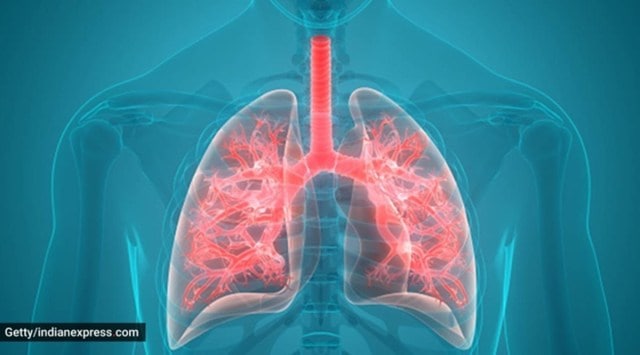📣 For more lifestyle news, click here to join our WhatsApp Channel and also follow us on Instagram
A pilot study suspects lung damage due to long-Covid; here’s what experts have to say
Patients are coming with cough and bronchitis symptoms for up to a month to 6 weeks after the infection," said Dr Jayalaxmi TK, consultant pulmonologist at Apollo Hospitals, Navi Mumbai
 About half of all COPD cases worldwide are due to non-tobacco-related risk factors, according to the researchers. (File)
About half of all COPD cases worldwide are due to non-tobacco-related risk factors, according to the researchers. (File)A long Covid is when symptoms persist for months following the initial infection, the most common being breathlessness. And the investigations regarding the mechanisms driving breathlessness remain unclear, states a pilot study published on Oxford Biomedical Research Centre, titled The Investigation of Pulmonary Abnormalities using Hyperpolarised Xenon Magnetic Resonance Imaging in Patients with Long-COVID.
The research included 11 non-hospitalised long-COVID (NHCL) and 12 post-hospitalised Covid-19 (PHC) patients along with 13 healthy people who underwent Hyperpolarized Xenon Magnetic Resonance Imaging (Hp-XeMRI) along with lung function tests, 1-minute sit-to-stand test and breathlessness questionnaires.
The study found that there abnormalities in the RBC:TP or red blood cell to tissue plasma ratio in NHCL and PHC patients. It also stated that lower TLco was observed in NHLC patients as compared to PHC patients which “demonstrate significantly impaired gas transfer in non-hospitalised long-COVID patients when all other investigations are normal.” The British Lung Foundation defines TLco as the gas transfer test that “measures how your lungs take up oxygen from the air you breathe.”
The study further stated that these abnormalities are “present many months after the initial infection”.
Dr Jayalaxmi TK, who is a consultant pulmonologist at Apollo Hospitals, Navi Mumbai, shared her opinion, stating, “We are seeing persistent lung involvement in the patients who had mild to moderate or severe infection following first and second wave. For the third wave, it is too early to say, but we are seeing persistent lung symptoms like cough and breathing difficulties with wheezing and bronchitis-like symptoms.”
She further added, “After the first and second wave, lung involvement was common in long COVID. CT scans were sometimes normal, but mostly showed resolving fibrosis or resolving pneumonia-like picture.”
She also said even though lung damage or pneumonia is not seen in the third wave, “patients are coming with cough and bronchitis-like symptoms for up to a month to 6 weeks after the infection.”
Dr Rohan R Naick, Consultant Pulmonologist, SPARSH Hospital, concurred, saying, “In the current study, a Hyperpolarized Xenon MRI scan was done, and the scans have shown that there is some impairment of gas exchange i.e the oxygen is not passing normally.”
He added that “these are very early findings and a larger study needs to be done to be sure about the implications of this.”
📣 For more lifestyle news, follow us on Instagram | Twitter | Facebook and don’t miss out on the latest updates!
📣 For more lifestyle news, click here to join our WhatsApp Channel and also follow us on Instagram



- 01
- 02
- 03
- 04
- 05
























